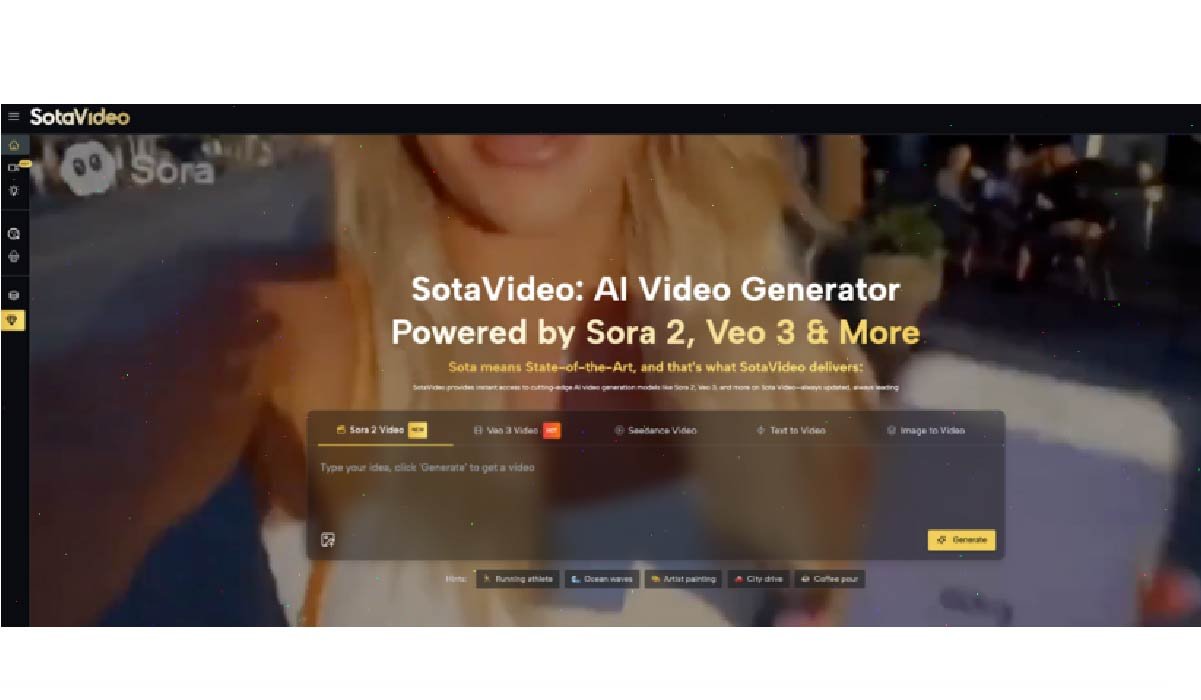Tech
Why Choose Sota Video Platform for Sora 2 and Veo 3 Generation

In the rapidly accelerating world of Artificial Intelligence, the gap between imagination and reality is closing faster than ever before. We have transitioned from the early days of glitchy, low-resolution GIFs to an era of hyper-realistic, cinematic video generation. At the forefront of this revolution are two technological titans: OpenAI’s Sora 2 and Google’s Veo 3.
However, for many creators, accessing these “State-of-the-Art” (SOTA) models remains a challenge. High barriers to entry, exclusive waitlists, and complex API integrations often keep the best tools out of reach for the average user.
This is where Sota Video changes the game.
Designed as a unified hub for the world’s most advanced video generation engines, Sota Video has established itself as the premier platform for creators who demand nothing less than the best. In this deep dive, we will explore why Sota Video is the ultimate solution for harnessing the power of Sora 2 and Veo 3, and how it is democratizing high-end video production for everyone.
What is Sota Video?
To understand the value of Sota Video, we first need to appreciate the technology it hosts. 2025 has been a landmark year for generative video, defined by the release of two specific models that have redefined the industry standards.
1. Sora 2: The World Simulator
Building on the viral success of the original Sora, Sora 2 architecture is not just a video generator; it is a physics engine. It understands how light interacts with glass, how fabric moves in the wind, and how objects exist in 3D space. It excels at long-form content, maintaining character consistency over extended durations-a feat that was previously impossible.
2. Veo 3: The Cinematic Powerhouse
On the other side of the spectrum is Veo 3, Google’s answer to high-fidelity media. Veo 3 is renowned for its semantic understanding. If you describe a complex emotional scene with specific camera movements (e.g., “a dolly zoom on a tearful eye”), Veo 3 executes it with the precision of a Hollywood cinematographer. It offers unparalleled resolution and frame rate smoothness.
The Problem: Fragmentation
While these models are incredible, they are often siloed. Using Sora 2 might require one subscription or interface, while Veo 3 requires another. For a creator, switching between platforms is inefficient and costly. Sota Video solves this fragmentation by bringing them under one roof.
Why Sota Video is the Best Platform for Creators
Sota Video is more than just a “wrapper” for AI models; it is a comprehensive workspace designed to optimize the generation process. Here is why it is currently the best platform for utilizing Sora 2 and Veo 3.
1. Unified Access to SOTA Models
The primary selling point of Sota Video is convenience. Instead of managing multiple accounts, Sota Video aggregates the capabilities of Sora 2, Veo 3, and other leading models into a single, intuitive dashboard. You can generate a scene using Sora 2’s physics engine, and then generate a variation using Veo 3’s cinematic rendering, all within the same project folder. This “model agnosticism” gives creators the freedom to choose the best tool for the specific shot they need.
2. Intelligent Prompt Enhancement
One of the biggest hurdles in AI video generation is “Prompt Engineering.” A vague prompt often leads to mediocre results.
Sota Video integrates an intelligent prompt assistant. When you type a simple concept like “A cyberpunk city in the rain,” the platform’s internal tools can expand and optimize this prompt for the specific model you are using. It might enhance it to: “Cyberpunk metropolis at night, neon lights reflecting on wet pavement, heavy rain, volumetric fog, 8k resolution, shot on 35mm lens, highly detailed, Sora 2 style.” This ensures you get the highest quality output without needing to be a prompt expert.
3. High-Performance Rendering
Rendering high-definition AI video is computationally expensive. Sota Video leverages a robust cloud infrastructure that minimizes wait times. While free access points to these models often suffer from server overload and long queues, Sota Video prioritizes user requests, ensuring that your creative flow isn’t interrupted by a loading screen.
4. User-Centric Interface
The interface is designed for non-coders. It features a clean “Workbench” where you can easily toggle between Text-to-Video and Image-to-Video modes. Settings like aspect ratio (16:9, 9:16), duration, and motion intensity are presented as simple sliders and buttons, removing the technical complexity associated with raw API usage.
Creating Your First Masterpiece on Sota Video in 4 Steps
If you are ready to dive in, here is a guide on how to maximize your experience on the platform.
Step 1: Choose Your Model
Upon logging into Sota Video, navigate to the creation dashboard. You will see options to select your underlying engine. For realistic, physics-heavy scenes (like crashing waves or moving vehicles), select Sora 2. For stylized, narrative-driven clips with complex camera moves, select Veo 3.
Step 2: Craft Your Prompt
Enter your text description. Be as specific as possible regarding:
- Subject: Who or what is in the video?
- Action: What are they doing?
- Environment: Where is it happening?
- Lighting/Style: Is it cinematic, cartoon, noir, or sunny?
Pro Tip: Use the “Enhance Prompt” button on Sota Video to automatically add detailed keywords.
Step 3: Configure Settings
- Aspect Ratio: Choose 16:9 for YouTube or 9:16 for TikTok/Reels.
- Duration: Select your clip length (usually 5s or 10s).
- Image Input (Optional): If you want to animate a specific photo, upload it here to use the Image-to-Video feature.
Step 4: Generate and Iterate
Click “Generate.” Within moments, your video will appear. Sota Video allows for easy iteration-if the movement isn’t quite right, you can tweak the motion settings and regenerate without re-typing the whole prompt.
Real-World Use Cases
Who is Sota Video actually for? The versatility of Sora 2 and Veo 3 makes this platform essential for various industries.
- Marketing Agencies: Create high-conversion video ads for social media without the cost of a physical shoot. You can generate product showcases in exotic locations purely through AI.
- Indie Filmmakers: Use Sota Video for pre-visualization (pre-viz). Before hiring actors and renting locations, directors can generate the entire storyboard as a video to visualize the pacing and lighting.
- Social Media Influencers: The algorithm loves high-quality video. Sota Video allows influencers to create “viral” visual hooks—surreal, impossible scenes that grab attention in the first 3 seconds of a Reel or TikTok.
- E-Commerce: Transform static product photos into dynamic videos. An image of a shoe can be turned into a video of the shoe stepping into a puddle, adding life to a static catalog.
Conclusion
The launch of Sora 2 and Veo 3 marks a turning point in creative history. We are moving away from the constraints of physical production and into an era where the only limit is your imagination. However, powerful technology is useless if it isn’t accessible.
Sota Video bridges this gap. It democratizes access to the world’s most powerful “World Simulators,” wrapping them in an interface that is easy enough for a beginner but powerful enough for a professional.
Whether you are a marketer looking to cut costs, a filmmaker looking to experiment, or just a curious creative, Sota Video is your gateway to the future of media. Don’t just watch the AI revolution happen-be a part of it.
Visit Sota Video today and start creating the impossible.
-

 Celebrity1 year ago
Celebrity1 year agoWho Is Jennifer Rauchet?: All You Need To Know About Pete Hegseth’s Wife
-

 Celebrity1 year ago
Celebrity1 year agoWho Is Mindy Jennings?: All You Need To Know About Ken Jennings Wife
-

 Celebrity1 year ago
Celebrity1 year agoWho Is Enrica Cenzatti?: The Untold Story of Andrea Bocelli’s Ex-Wife
-

 Celebrity1 year ago
Celebrity1 year agoWho Is Klarissa Munz: The Untold Story of Freddie Highmore’s Wife
















